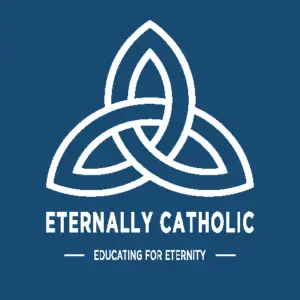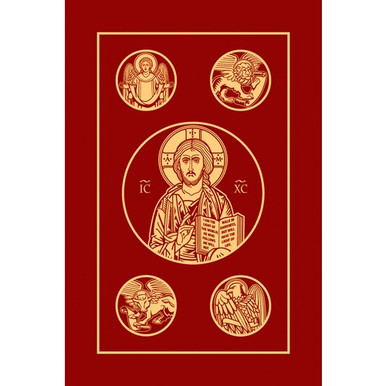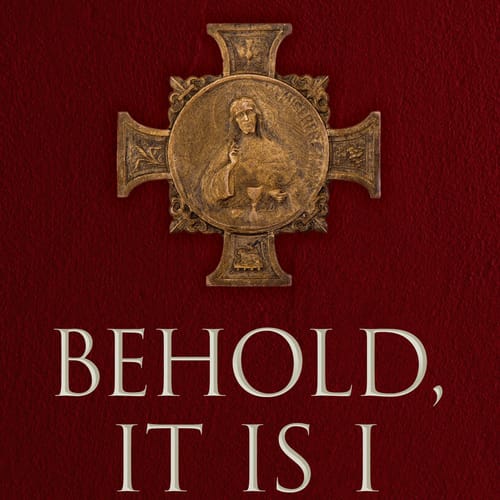This post contains affiliate links.
The Sacrament of Eucharist is the third of the Sacraments of Initiation. It is a visible sign of invisible grace which was instituted by Jesus Christ at the Last Supper. The Eucharist is the true Body and the true Blood of Jesus Christ, who is really and substantially present under the appearance of bread and wine as nourishment for our souls during the Mass at the consecration.
The Sacrament of Eucharist or Holy Communion is the real presence of Jesus under the appearance of bread and wine, instituted at the Last Supper, through the words “This is my body. This is my blood. Do this in memory of me,” the bread and wine changed into the body and blood of Jesus Christ known as transubstantiation. This is celebrated and offered in every Mass throughout the world, and throughout the ages.
The sacrament of Eucharist was instituted at the Last Supper. Throughout the Old Testament, there are references to this future and eternal offering. In the gospel off St John the evangelist and especially in chapter 6, our Lord and saviour Jesus Christ, refers strongly to the sacrament of the Eucharist. This is known as the “Discourse on the Eucharist”.
According to the Catechism of the Catholic Church (CCC):
“The Eucharist is the “source and summit of the Christian life” (CCC1324)
This therefore places the Sacrament of the Eucharist as the central place by which all the other sacraments are bound up with and point to.
It is a commonly held Catholic and theological belief that (and by definition):
“The Holy Eucharist is the true Body and true Blood of Jesus Christ, who is really and substantially present under the appearances of bread and wine at the consecration during the Mass.”
There are two main references in Scripture that bring this all together – St John Chapter 6, often called ‘The Discourse on the Bread of Life” and often ignored by many Protestants and unaware by most Catholics; and the Last Supper Narrative as found in all the Gospels.
Let me begin with an explanation of the Passover which correlated with the Last Supper.
What is the Passover?
For the benefit of those who may not be aware of the Passover, the Passover is the event in the life of the Jewish people that resulted in the Jewish people being freed from the hands of Egyptian slavery. God had finally heard the people’s pleas and prayers and needed the cooperation of Pharaoh. Having received word from Moses of the request by God to free the Hebrew people, Pharaoh continued in his obstinance, even though God had sent plague after plague – ten in total.
The final plague would see Pharoah finally cave into God’s demands.
The Israelites were commanded by God (YHWH) through Moses to slaughter a male Lamb of one year of age and without blemish (Exodus 12:5) and with the blood of the lamb it shall be on both the side posts and upper posts of the house (Exodus 12: 7) and the flesh of the slaughtered lamb shall be eaten that night roasted at the fire along with unleavened bread (Exodus 12: 8).
It is that very evening as the side and upper posts of each of their houses were marked, and as they ate of the slaughtered roasted lamb, the first born of every male was killed by the Angel of God (Exodus 12: 19).
Pharoah’s first born son would be a victim of God’s wrath, and resulted in him caving into the request to let the people go (Exodus 12: 31-51).
The Israelites were then freed from the slavery of the Egyptians and commenced their journey, crossing the Red Sea and into the wilderness to find their home in the promised land.
The Passover meal or Pasch is to be replaced by the ultimate sacrifice of Jesus Christ. Jesus would not only be the one making the offering (Priest) but will also be the one being offered (Victim). The Last Supper is where the first Mass took place and that this Mass would not just be a sign, but a new and everlasting sacrifice given to all and the Real Presence that will be made possible through every Mass throughout the ages. Jesus will be present in the bread (His Body) and the wine (His Blood) and a re-presentation of the event at Calvary – a Bloodless Sacrifice. Jesus’ sacrifice is a deliverance from the slavery of sin.
Of worthy note are the following:
The first sin known as Original Sin, committed by our first parents, Adam and Eve, begins with the eating of the forbidden fruit of the tree of knowledge of good and evil. The freeing of the Israelites from slavery at the hands of the Egyptians was though eating and the freedoms from sin at the Last Supper also involved eating. This eating would be the Body of Jesus and the drinking of Jesus’ Blood.
And:
During the Passover meal, the bread and wine are mentioned but not the Lamb.
Why is the lamb not mentioned during the Last Supper?
It is because the unblemished lamb, the one who is sinless is Jesus Christ. Jesus is the Lamb of God, who takes away the sin of the world.
And:
Jesus takes the bread (which becomes His Body) and the wine (which becomes His Blood) separately.
This is to indicate that Jesus will shed His Blood during His Passion and when the lance pierced His side that blood and water would flow from His side; and that His Body would be offered as a sacrifice.
Where is the Sacrament of Holy Eucharist or Holy Communion in the Bible?
Recommended Catholic Bibles, Catholic Resource Website and Outstanding Catholic Research Software:
The word ‘Eucharist’ comes from the Greek word Greek eucharistia, which simply means “thanksgiving” but what is it that we are being thankful for? What is this thanksgiving? In order to fully understand the nature of the Eucharist we will draw upon the rituals and sacrifices from the Old Testament – the Old Law, after all Jesus not only prepares His followers, the Jews and future generations for this ultimate sacrifice, offering, eating and Eucharist, He chose a Jewish day of remembrance and memorial to institute this Sacrament of the Eucharist at the Last Supper.

For Jesus chose the Passover meal, the day before He would suffer and die on the Cross, to institute the Sacrament when He said:
“… With desire I have desired to eat this pasch with you, before I suffer (St Luke 15:22).
The Passover meal is the setting of the first Mass (see St Matthew 26:20–29; St Mark 14:17–25; St Luke 22:14–38; and St John 13).
It is with detail that we read about the “bread of life” in the Gospel of St John Chapter 6, as this “I am the Bread of life”, and “Eat this Body”, and “Drink my Blood”, are fulfilled during the Last Supper. This is known as the ‘Discourse of the Bread of Life”.
The Gospel of St John, Chapter 6 is worth the read, reflection, and study. For in this chapter, we are made of aware of the need to have faith in the words of Our Lord and that Jesus not only meant what He said, He said what He meant.
Jesus was not speaking symbolically or metaphorically.
This is where our Protestant brethren fail to understand.
This Chapter is worth reflecting on for the Last Supper fulfills the promise of Jesus and every Mass, since that first Mass, continues to do the same.
Jesus leaves no doubt that he is referring to the Eucharist in the “Bread of Life discourse” (St John 6:35–65).
I would like to set the scene from the Gospel of St John Chapter 6.
What is St John’s Gospel Chapter 6 about?
The gospel of Saint John, and in particular chapter 6, is focused on the discourse on “the bread of life”. Chapter 6 begins by setting the scene of the multitude of people who had followed Jesus after he had performed many miracles.
In verse 4 we hear that “the Pasch, that is the festival day of the Jews was very near”, and that Jesus would soon have his last meal with his Apostles before he would die and be resurrected.
In verses 5-13, Jesus upon seeing the multitude was looking for a way in which to feed them and asked Phillip that very question.
Saying that there wasn’t enough to feed the multitude, Andrew sees a boy who has five bread loaves and two fishes. The 5000 are asked to sit down. Then taking the five loaves and two fish the Lord gives thanks and He feeds all of them.
Not only did Jesus feed 5000 people, there were twelve baskets filled and left over.
Jesus knew that following this miracle that people began to see Him as the foretold prophet (see verse 15). Jesus then flees the scene and goes over the sea to Capernaum.
The very next day, they notice Jesus on the other side of the sea and they followed him via their boats.
Upon questioning Him about his comment regarding the labour for the meat which perisheth. Jesus asked them to labour for the things that would last forever and that to believe in the one whom God had sent [see St John 6: 27-29].
In verse 30, Jesus had just completed a miracle in feeding 5000 and previous to that, many other miracles, which resulted in them following Him in the first place, they continue to ask Him what sign he would give them that they would be able to believe? Then Jesus begins his discourse on the bread of life.

From verses 31-to 60, Jesus makes the following points:
– The Father would give them true bread from heaven.
– The people asked that they receive this bread always, but Jesus said to them
“I am the bread of life”.
– Jesus asked the people on several occasions to believe in Him.
– The Jews begin murmuring about this teaching that Jesus said that He is the “living bread which came down from heaven.”
– In verses 48-52 Jesus says: “I am the bread of life. Your Father’s did eat manna in the desert: and are dead. This is the bread which cometh down from heaven calling that if any man eat of it, he may not die. I am the living bread which came down from heaven. If any man eat of this bread, he shall live forever: and the bread that I will give is my flesh, for the life of the world.”
-In verse 53 the Jews said: “how can this man give us his flesh to eat?”
In verses 54-60 Jesus repeats this saying and re-emphasise His teaching:
“… Except you eat the flesh of the son of man and drink his blood, you shall not have life in you. He that eateth my flesh and drinketh my blood hath everlasting life: and I will raise him up in the last day. For my flesh is meat indeed: and my blood is drink indeed.
He that eateth my flesh and drinketh my blood abideth in me: and I in Him.”
In verses 58-59, Jesus continues:
“As the living father have sent me and I live by the Father: so he that eateth me, the same also shall live by me. This is the bread that came down from heaven.
Jesus repeats again to them “not as your father’s did eat manner and are dead. He that eateth this bread shall live forever.”
Jesus ends the discourse on the “bread of life” just as He begins it and this teaching was given in the Synagogue, in Capernaum (St John 6: 60).
After completing this discourse on the bread of life, the rest of the chapter takes a interesting turn. Jesus sees that they are scandalised by this teaching And we read in verses 61-67 that many found this teaching difficult to understand, did not believe Jesus and as it says in verse 67:
“After this, many of his disciples went back Ann walked no more with him.”
Then Jesus in verse 69 turns to the twelve, the chosen Apostles and asks them a rather direct question:
“Will you also go away?”
St. Peter makes a statement of faith, belief and trust in Jesus:
“Thou has the word of eternal life Lord, to whom shall we go? And we have believed and have known that thou art the Christ, the son of God.”
Finally, Jesus turns to them in verse 71 and says to the Apostles:
“One of you is a devil.”
What can we learn about the Eucharist from St John Chapter 6 – “Discourse on the Bread of Life”?
How important in the Eucharist?
From this Chapter 6 in St John’s Gospel, Jesus makes a promise of a bread that is His flesh, His Body and His very self that we are asked to eat to gain eternal life.
It is also interesting that Saint John begins the chapter announcing that the Pasch, that is the Passover, was near, and as we are aware from all the Gospel writers that Jesus broke the bread and said the words “this is my Body”. Then He blessed the cup of wine and said “this is my Blood”. The very words that Jesus speaks in Saint John’s Gospel Chapter 6 are the words that he uses in the Last Supper narrative.
Jesus says “do this in memory of me”, Jesus gives us and institutes the holy mass where the bread and wine I turned into the body and blood of Jesus for which we partake of during holy communion.
Jesus repeats the bread of life discourse six times and by big inning with “Amen, Amen, I say unto you …” Jesus is making of what equates to an oath.
The Eucharist, according to the Catholic Church and as witnessed in the Catholic Masses offered validly all around the world, is the most central, important, necessary and fulfilment of the very words of Jesus “eat my flesh and drink my blood.”
Was Jesus speaking metaphorically or symbolically?
Was Jesus speaking metaphorically or symbolically? This is an often-debated misunderstanding of what Catholics understand the Eucharist to be. If Jesus was speaking symbolically, why would he risk losing all those who had followed him? Jesus could have easily said to the many who were scandalised by His teaching that “I was only speaking symbolically”. But Jesus did not speak symbolically in this chapter, for Jesus meant what he said, and said what he meant.
Jesus from the outset commenced His discourse on the bread life by asking those to believe in Him as this teaching would require faith, trust, and belief. It is a very difficult teaching to understand and to intellectualise by mere mortals. Jesus is asking us and all those around Him to have faith, to trust and to believe. This is made apparent by the words of Saint Peter at the end of the chapter where he says to Jesus:
“Thou hath the word of eternal life Lord, to whom shall we go? And we have believed and have known that thou art the Christ, the son of God.”
Believing that Jesus is truly present in the bread and in the wine which are at the words of consecration in the Mass turned into his body and blood where Jesus is truly present both in his divinity, humanity, body and blood is truly a matter of faith, belief and trust. Jesus words should be good enough for those who believe in him. Sadly, this is not the case for our Protestant brethren, for this is a matter of division.
Why did Jesus say that one of His twelve is “a devil”?
The question as to why Jesus referred to one of the Apostles as “a devil”, is in reference to Judas Iscariot, the one who would betray him.
As Saint Paul tells us in 1Corinthians 11:27-29:
“Therefore, whosoever shall eat this bread, or drink the chalice of the Lord unworthily, shall be guilty of the body and of the blood of the Lord. But let a man prove himself: and so let him eat of that bread and drink of the chalice. For he that eateth and drinketh unworthily eateth and drinketh judgment to himself, not discerning the body of the Lord.”
Both our Lord Jesus and Saint Paul here are referring to those who receive the Body and Blood in the form of bread and wine unworthily that is without belief, living in sin, lack of understanding and catechesis as to what they and whom they are receiving; bring unto themselves condemnation or judgement should they receive Jesus in this state.
When Jesus calls one of the twelve a devil, Jesus knew the heart of this Apostle, He knew his lack of belief, that his heart had turned away from the love of Jesus, that he would betray him, Jesus says:
“The Son of man indeed goeth, as it is written of him. But woe to that man by whom the Son of man shall be betrayed. It were better for him, if that man had not been born.” (St Matthew 26:24).
Clearly, this is not just symbolism. This is Jesus present in the bread and the wine, which turn into his Body and Blood at the words of the priest at the consecration in the Mass, through what Catholics call transubstantiation.
What is meant by the word ‘Transubstantiation’?
“In the theology of the Eucharist, the conversion of the whole substance of the bread and wine into the whole substance of the Body and Blood of Christ, only the accidents (i.e. the appearances of the bread and wine) remaining” (The Oxford Dictionary of the Christian Church, 2005:648).
At the Last Supper Our Lord took bread and said over it: “This is My Body.” Then, wine over which he said: “This is My Blood.” The words of Jesus effected what they signified. To understand the word “transubstantiation” a clear understanding of the difference between “substance” and an “accident” is needed.
What is meant by “substance” and an “accident”?
Substances – that is which and exists on their own or in their own right. For example, a piece of bread exists on its own and not in another. It is simply a piece of bread.
Accidents – is that by which a substance is such and such. Existing only in another. Also sometimes called species or appearances, since it is through them that a substance appears or makes its presence known to us. For example, if we tale the piece of bread and try to describe it, we describe it in comparison to something else that exists for example it is square or it is white or it tastes like something or size, weight, temperature. It exists in this case in reference to something else.
At the Last Supper, Jesus did not say “the weight of this bread is my body,” or “the shape of this bread is my body,” or “the quantity of this bread is my body.”
Jesus did not refer to that accidental nature of the bread. Jesus said, “This is my body.”
This bread which becomes the Body of Jesus is the substance.
This is also the case with the wine. Jesus did not say “this red wine is my blood”, nor did he say “this quantity of wine is my blood”. Jesus said, “This is my blood”.
The wine which becomes the Blood of Jesus is the substance.
Therefore, both the substance of the bread and the wine are substantially changed into the Body and Blood of Jesus. However, the accidents remain unchanged – they still look like bread and wine, taste like bread and wine, etc.
Nothing in nature can achieve this substance change without effecting an accidental change. Only God can achieve a change in the substantial form of a thing, but also the matter. The complete substance, matter and form, is changed into another substance so that nothing remains of it except its accidents. This is what the Catholic Church calls Transubstantiation.
Is the Eucharist a Sacrament?
The Eucharist is a sacrament as it is a sign of the sacrifice offered by Jesus Christ [the priest] and the one who is being offered [sacrifice]. This offering is made to the Father in the Holy Sacrifice of the Mass and is made through the consecratory actions and prayers of the priest.
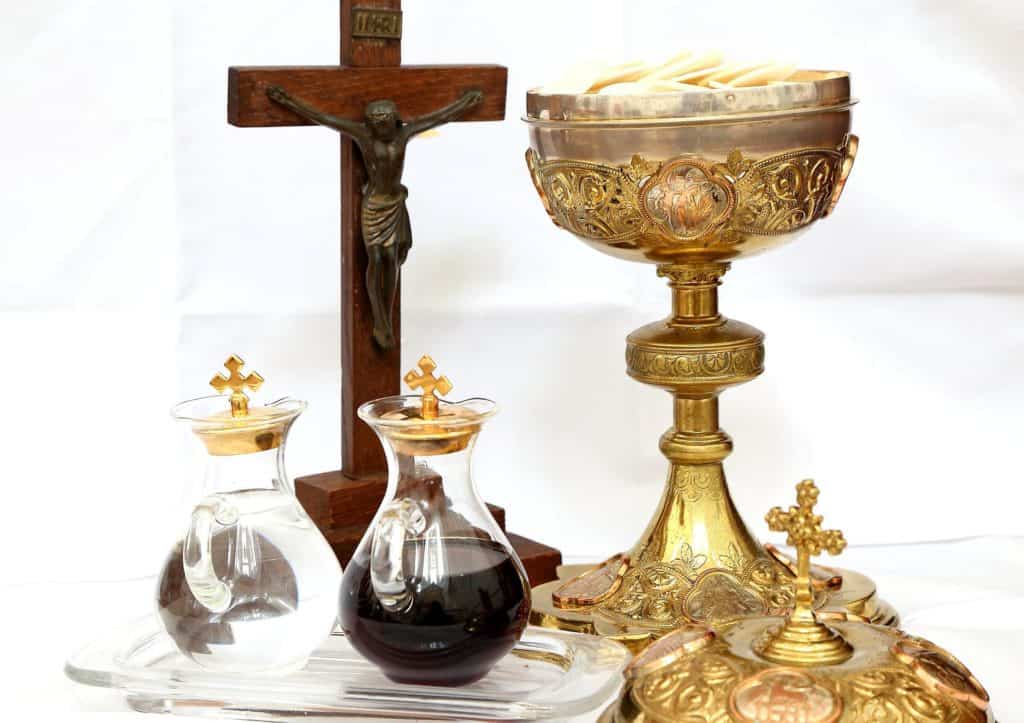
Therefore, through the Mass offered throughout the world, the Sacrament of the Eucharist is a sign which gives grace to those who approach worthily to receive Jesus under the appearance of bread-this is my Body! Jesus Christ humbled himself in the form of a piece of bread-innocent and vulnerable, and we are invited to receive him. Yes! Jesus is truly present under the appearance of bread and wine as stated in The Catechism of the Catholic Church (CCC) paragraphs 1373- 75:
““Christ Jesus, who died, yes, who was raised from the dead, who is at the right hand of God, who indeed intercedes for us,” is present in many ways to his Church: in his word, in his Church’s prayer, “where two or three are gathered in my name,”198 in the poor, the sick, and the imprisoned, in the sacraments of which he is the author, in the sacrifice of the Mass, and in the person of the minister. But “he is present … most especially in the Eucharistic species.”” (CCC1373)
“The mode of Christ’s presence under the Eucharistic species is unique. It raises the Eucharist above all the sacraments as “the perfection of the spiritual life and the end to which all the sacraments tend.” In the most blessed sacrament of the Eucharist “the body and blood, together with the soul and divinity, of our Lord Jesus Christ and, therefore, the whole Christ is truly, really, and substantially contained.” “This presence is called ‘real’—by which is not intended to exclude the other types of presence as if they could not be ‘real’ too, but because it is presence in the fullest sense: that is to say, it is a substantial presence by which Christ, God and man, makes himself wholly and entirely present.”” (CCC1374)
“It is by the conversion of the bread and wine into Christ’s body and blood that Christ becomes present in this sacrament. The Church Fathers strongly affirmed the faith of the Church in the efficacy of the Word of Christ and of the action of the Holy Spirit to bring about this conversion. Thus St. John Chrysostom declares:
It is not man that causes the things offered to become the Body and Blood of Christ, but he who was crucified for us, Christ himself. The priest, in the role of Christ, pronounces these words, but their power and grace are God’s. This is my body, he says. This word transforms the things offered.
And St. Ambrose says about this conversion:
Be convinced that this is not what nature has formed, but what the blessing has consecrated. The power of the blessing prevails over that of nature, because by the blessing nature itself is changed.… Could not Christ’s word, which can make from nothing what did not exist, change existing things into what they were not before? It is no less a feat to give things their original nature than to change their nature.” (CCC1375).
What happens during the consecration at a Catholic Mass?
At every Catholic Mass around the world the following take place during the words of the Priest at the consecration.
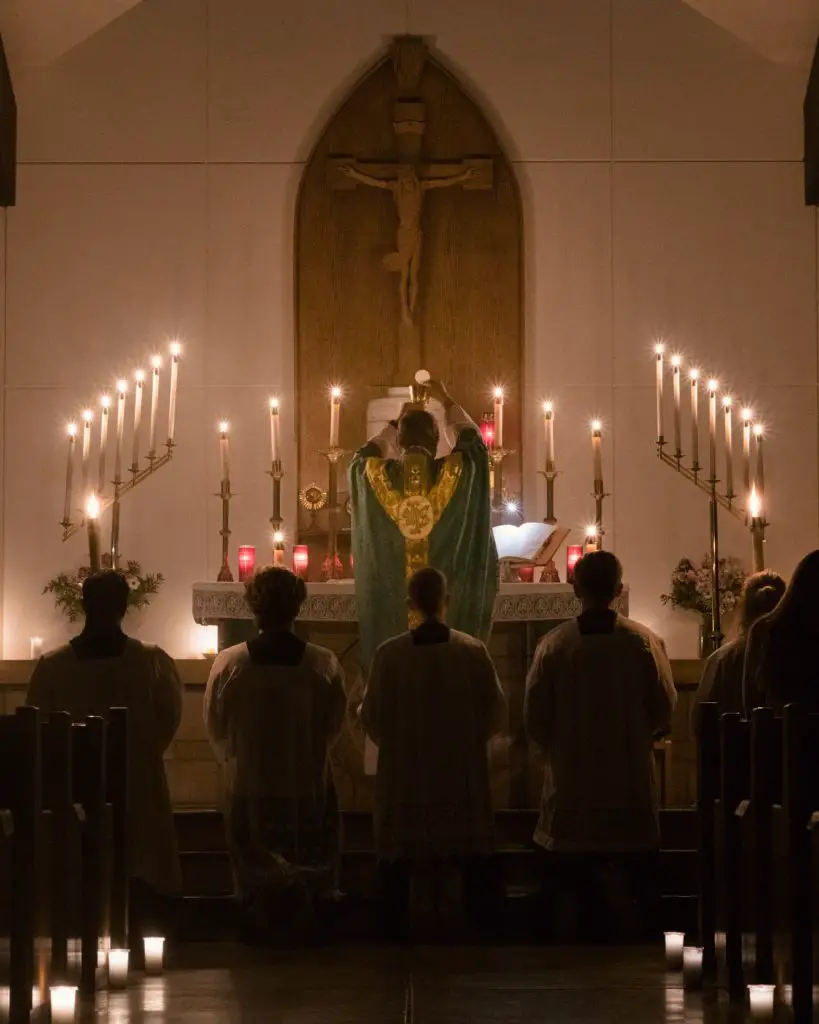
- The Bread and Wine remain accidently present, and their substance is change hence Transubstantiation, into the Body and Blood of Jesus. Jesus is Truly present.
- The Body and Blood are separated sacramentally i.e. The Bread at the words of the Priest “This is My Body” changes into His Body; and the words “This is My Blood” changes into His Blood. There is a separation of Christ’s Body and Blood on the altar.
- The Whole Christ is present under the appearance of Bread and Wine. When we receive Holy Communion, we receive Jesus’s Body, Blood, Soul and Divinity by what is called Concomitance which means “to accompany as a companion”. We can never separate His Divinity and His Humanity known as the Hypostatic Union.
- Christ is present with His Actual Dimensions or Natural Stature. Christ is not bound by space nor by time. Christ can be present in all Hosts around the world simultaneously.
- Christ is present in every Part of the Host. Whether in the full host or a part of the host, Jesus is present fully. We don’t break up Jesus into parts. Each part or piece is a whole.
What is the “Form” and “Matter” of the Sacrament of the Eucharist?
It may (may not be) evident that the Matter of the Sacrament of the Eucharist are the bread and wine. These are the physical substances that will be transformed into the Body and Blood of Jesus through the consecratory prayers. The words “This is my Body. This is My Blood. Do this in commemoration of me” are the Form of the Sacrament of the Eucharist. This is the Catholic Mass and is the representation of Calvary. Not a new sacrifice, but we are all taken to Calvary.
What are the benefits of the Sacrament of the Eucharist?
The Sacrament of Eucharist or Holy Communion, when received worthily (see section on How to
prepare for a worthy Holy Communion?), gives the communicant the following:
- We are united intimately with Jesus who enters into our bodies in Person.
- We are bonded to others through the Mystical Body.
- We receive Grace.
- Our charity is enhanced.
- Increase in the functioning of the gifts and fruits of the Holy Spirit.
- It sustains, strengthens, repairs, and delights us.
- It gradually makes our body like that of Our Lord.
- Means to controlling our passions.
- Gives us a share in the life, death and resurrection of Jesus.
- We partake of the Heavenly banquet.
- We are present in worship with entire communion of saints, angels and our Blessed Mother.
- It is a perfect way of worshipping God.
- Share in the life of the Holy Trinity.
- Share in eternal life as our Lord promised.

How to prepare for a worthy Holy Communion?
We should never approach the Sacrament of Holy Communion without a proper and worthy disposition. One often hears that Holy Communion is for the sick. Holy Communion is for all those who have sought the Sacrament of Reconciliation, the sacrament by which the spiritually sick humbly receive the King of Kings with a clear and loving heart, freed from the stain of mortal sin.
In order to receive the Sacrament of Holy Communion validly and worthily the following are required:
- Must be Baptised.
- In a state of Grace.
- Have fasted for at least one hour. This is stated in Canon 919:
“One who is to receive the Most Holy Eucharist is to abstain from any food or drink, with the exception only of water and medicine, for at least a period of one hour before Holy Communion.”
NB: Anyone in danger of death, for instance, may receive Communion even when not fasting. Invalids who have been in bed for a month and who have no certain hope of a quick recovery may receive Communion once or twice a week, though they have taken some liquid as medicine or nourishment beforehand.
